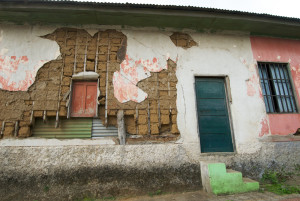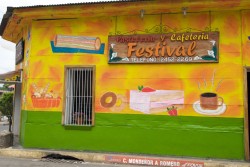Text by Mary L. Peachin with photos by David Lovitt
October, 2015, Volume 20, No. 1
Turismo Somos Todos Y Es Tarea de Todos is “everyone’s challenge.” –Anonymous

El Salvador, Country of Eternal Smiles, is Central America’s smallest, most densely populated republic. Best known for its Sunzal and Punta Roca surfing destinations and Costa del Sol and Cóbanos sport fishing, traveling between states, known as departments, usually involves “only forty minutes” of travel.
Honduras is the country’s northern and eastern border, Guatemala lies to the west. From the mouth of Rio Paz to the Bay of Fonseca, El Salvador’s 16,000 square miles include 190 miles of Pacific Ocean shoreline. Open to tourism in recent years, El Salvador offers a variety of interesting day trips featuring handicrafts, volcanoes, Maya archaeology, even a museum in an area of former guerrilla outposts.

In 595 AD, a Mayan village, now known as UN World Heritage Site Joya de Cerén, was buried by the volcanic eruption of Laguna Caldera. In 1976, the village was discovered by accident. Wealthy remains without any skeletons indicate that village residents fled in a hurry. It is considered the “Pompeii of America.”
It’s easy to traverse the country in a day. La Cocotera eco lodge and resort, located south near the Guatemala border, is wedged between the Pacific Ocean and Barra de Santiago estuary and village. Waterfront accommodations have stepping stones on the sand to link its swimming pool, open air restaurant ramada and bar. Located on the deciduous Pacific Slope dry forest of El Imposible National Park, the resort’s natural landscape has more than a hundred coconut palms plus mango and almond trees.

In the more southern seaport of Acajutla, Los Cóbanos Coral Reef is one of El Salvador’s five protected national parks in the country. Between November and May, the dry season when the ocean transitions from murky to crystal blue, light tackle anglers come for sport fishing. Other months of the year yellowfin, grouper, snapper, dorado, Spanish mackerel are targeted. Billfish include four species of marlin: black, blue, white and striped. Roosterfish fish swim along rolling breakers between November and February.
Fishing out of Los Cóbanos, we waded into the surf to board the “Mahi-Mahi“, a twenty seven foot Pesqueros Guatemala fiberglass panga with two 75 HP Mercury engines. The boat’s fighting chairs with cushioned seats has plenty of space for stand up fishing.
Heading into the Pacific multiple schools of spinner dolphins performed acrobatics, turning and jumping out of the water. Captain Jose “Chepe” Morano or “El Diablo” and First Mate Oscar Rene Mejia knew their fishing. Oscar would nimbly stand on the bow or stern railing scanning for fish. By the time we headed in, we caught and released more than a dozen fish dorado and blackfin tuna.

Five to six thousand years ago, Lago de Coatepeque, an hour from San Salvador, catastrophically erupted along the eastern slope of Santa Ana volcano. Sparkling blue, the 120 m deep crater-shaped lake is a mile wide is surrounded by steep green slopes rising up 250 to 500 meters.
A few blocks away, the commonly known “naked woman” is the Monument of The Constitution. Her arms raised with a sword and weight balance, she represents justice. Her nakedness symbolizes that she has nothing to hide. Life was not always so tranquil in El Salvador. Between 1980 and 1992, the Salvadorian army fought with guerillas in a bloody revolution, one that killed 75,000 not including many who disappeared. It is estimated that three million fled to the United States.

Fields of sugar cane are interspersed with fields of lava rock. Guide Mosés Flores stops at Joyen De Ceren. One of El Salvador’s archaeological sites, it was named a UN World Heritage Site in 1993. While smaller in size, it has been called the Pompeii of America. Brightly colored fruit of the cashew nuts are in bloom. National bird of the country, the Torogoz or iridescent blue turquoise motmot flit among the ruins. The nest Chiltota bird hangs over the trail.
Joya De Ceren has one of the best preserved Mayan temascal or steam bath in world.

San Andres Parque Arqueologico pyramid is part of the volcanic complex spanning the country to Santa Ana. It includes the Mayan acropolis, a great plaza where the most important people lived.
El Salvador boasts excellent roads, women carrying baskets of firewood on their heads, and a number of cultural routes: Ruta flowers, volcanoes, archaeology, artisans, 1000 hills (coffee farms, natural mangrove forest.)
The city of San Salvador is overshadowed by El Boquerón, one of El Salvador’s thirty volcanoes. Six remain active. The country’s last major eruption was Santa Ana in 2005.
El Salvador is noted for its volcanoes and have established Volcano National Park which includes Izalco, Santa Ana and Cerro Verde offers panoramas of Izalco, “Lighthouse of the Pacific,” Santa Ana and Coatepeque lake.

Izalco Volcano, one of the world’s youngest volcanos erupted in 1770 and remained active until 1957. Coatepeque Lake named by Mayan “Place of the Serpents” is located in the shadow of the volcano of Santa Ana. Lake Coatepeque was originally a volcanic crater. Located twelve miles south of Santa Ana volcano, the Lake covers an area of twenty four square kilometers and almost 400 feet deep. It has been nominated for consideration as one of new natural wonders of world.
The mountainous thirty six miles between Sonsonate and Ahuachapán is known as the route or Ruta de Flower (or Ruta de las Flores) between the El Salvador towns of Nahuízalco, Salcoatitán, Juayúa. Apaneca, and Concepción de Ataco.

Nahuízalco’s indigenous community has an economy based on crafts made of natural fibers (osier, yute, and wood). Before electricity, the daily outdoor market was lit by candlelight during evening hours.
Honey, coffee, and sesame is processed in Salcoatitán. Juayúa or “Purple Orchid River” is noted for its gold grain or coffee. Apaneca and Concepción de Ataco claim to grow the finest coffee in the world.
Emilia Guevara, who teaches indigo dyeing at Casa Blanca Archaeological museum, explained how the Xiquilite or Indigo, which means blue plant, is fermented in water to oxidize it into deep blue color, one determined by the quantity of foam floating on the water. When the color is deep blue, the water is drained until the remaining plant becomes a paste. Dried into a powder, it is then formed into bricks then rehydrated into a dye that has the right smell, shine, and foam.

Suchitoto, a colonial style city with wide streets, is a municipality in the Cuscatlán department. It’s the main square of the colonial town of Suchitoto, with its church built by the Spaniards in the 1853. The village, which translates from the Nahuat language means “bird flower” is widely known throughout El Salvador for its church and cobblestone roads.
La Libertad is the destination for surfers. The closest beach is Sunzal, Of course, its forty minutes from San Salvador. “Small country, good roads, best in Central America.” Carlos Velasco.
If you go:
Los Cobanos Lodge www.loscobanos.com.sv on Playa Los Cobanos
Las Veraneras is Bouganvilla in Sonate in Los Cóbanos, www.veranerasresort.com
San Salvador Sheraton Plaza Presidente, www.sheraton.com
Salvadorean Tours, www.elsalvador.travel
GreenBlueRed Colorful Travel, www.GreenBlueRed.com
